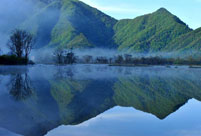


Backpackers set up tents on a plank road on a cliff in Laojun Mountain in Luoyang, Henan province, over the last weekend. [Photo by Wang Zhongju/China Daily]
The remarkable growth in outdoor travel in China became part of public consciousness in a dramatic way recently when more than 100 tourists camped on a "boardwalk" high up on a cliff-face of Laojun Mountain in Henan province. The camping party, which was widely covered by the media, had the luxury of being at a spot covered by WiFi, and one can imagine many of campers coming out of their tents early in the morning, taking photographs of the mist-swathed valley and uploading them instantly on social media, adding to the sensation of outdoor travel in China.
Indeed, the rise in outdoor travel is nothing short of a sensation: over the past decade I have seen remote tracts of wilderness develop from the haunts of outdoor fanatics to the playgrounds of droves of travelers. The majority of these recent travelers are not the outdoor types. They may value the aesthetics of the landscape, the fresh clean air, the rural sights, but they also tend to indulge in drinking and smoking, singing and playing cards, and wherever there is WiFi access it's common to see many of them glued to their smartphones, watching soap operas or engaged in social media. For them the landscape is just a backdrop; they don't immerse themselves in the full splendor and experience of their natural surroundings.
This phenomenon of camping for the sake of hunkering in a tent somewhere with a view has grown in popularity not only in China, but also in much of the world. In the West the growth has been more gradual, and the percentage of those who camp in the wilderness to feel nature by engaging in pursuits such as trekking and bird-watching is greater. In China, camping is a new pastime for youths and-bizarrely for someone who grew up in the West-most Chinese prefer to camp on hard surfaces, not grassy land.
I have over the years undertaken outdoor adventures with Chinese with different attitudes and interests, including pure nature lovers whose number has been increasing. Bird-watching clubs are booming. Outdoor activities such as trekking, mountain biking, rock climbing and wildlife photography, too, are on the rise. I know of a two-day trek in the mountains of Sichuan province where the number of annual trekkers wasn't even in the double digits till five years ago; today it is in the low hundreds. Hiking trails of all grades are propagating in China.
But while quite a few outdoor enthusiasts have taken to outdoor adventures with passion, many of the new converts seem unprepared for the perils and vagaries of the wilderness. I call them "romantics in the outdoors", people who don't pay heed to the two most basic precautions in the wilderness: never traipse into the wilderness alone and never go walking without a guide unless you are familiar with the trail and terrain.
These "romantics" often head into the woods and take mountain trails without a local guide, oblivious to the plethora of risks, unaware even of how easy it is to get lost and how rapidly weather conditions can deteriorate in the mountains. Worse, their trekking gear is unsuitable (many of these instant trekkers are in formal or semi-formal shoes and even high heels) and they carry no gear for eventualities (not even a torch).
It's foolish, no matter how experienced you are, to head into the wilderness away from roads, villages and campsites without being aware of the looming dangers (such as wildlife and perilous paths, to name just two). No wonder the casualty statistics make grim reading: the number of outdoor travelers who get lost or are injured every year is increasing, and the authorities have to expend valuable resources to mobilize search and rescue efforts. One should always keep in mind that wild landscapes are inspiring, but they can also be treacherous.
The author is a freelance writer who specializes in culture, travel and lifestyle.
 Who Will Fit The Chinese Roles In Game Of Thrones?
Who Will Fit The Chinese Roles In Game Of Thrones? China's Hubei Shennongjia added to World Heritage List
China's Hubei Shennongjia added to World Heritage List "Straddling bus" starts production in east China
"Straddling bus" starts production in east China Girl goes viral for finger-long toes
Girl goes viral for finger-long toes Five made-in-China hi-tech breakthroughs
Five made-in-China hi-tech breakthroughs HK-Zhuhai-Macao Bridge to open to traffic
HK-Zhuhai-Macao Bridge to open to traffic China opens its first combined transport service to Nepal
China opens its first combined transport service to Nepal Students take stylish bikini graduations photos
Students take stylish bikini graduations photos Charming dancing students pose for graduation photos
Charming dancing students pose for graduation photos Top 10 livable Chinese cities
Top 10 livable Chinese cities Top 20 hottest women in the world in 2014
Top 20 hottest women in the world in 2014 Top 10 hardest languages to learn
Top 10 hardest languages to learn China’s Top 10 Unique Bridges, Highways and Roads
China’s Top 10 Unique Bridges, Highways and Roads Turkey upheaval augurs challenges to West
Turkey upheaval augurs challenges to West Property rights don’t come easy for China’s urban homeowners
Property rights don’t come easy for China’s urban homeowners How a wholesale market becomes a playground in the holidays
How a wholesale market becomes a playground in the holidays China will face more trade remedy measures
China will face more trade remedy measuresDay|Week